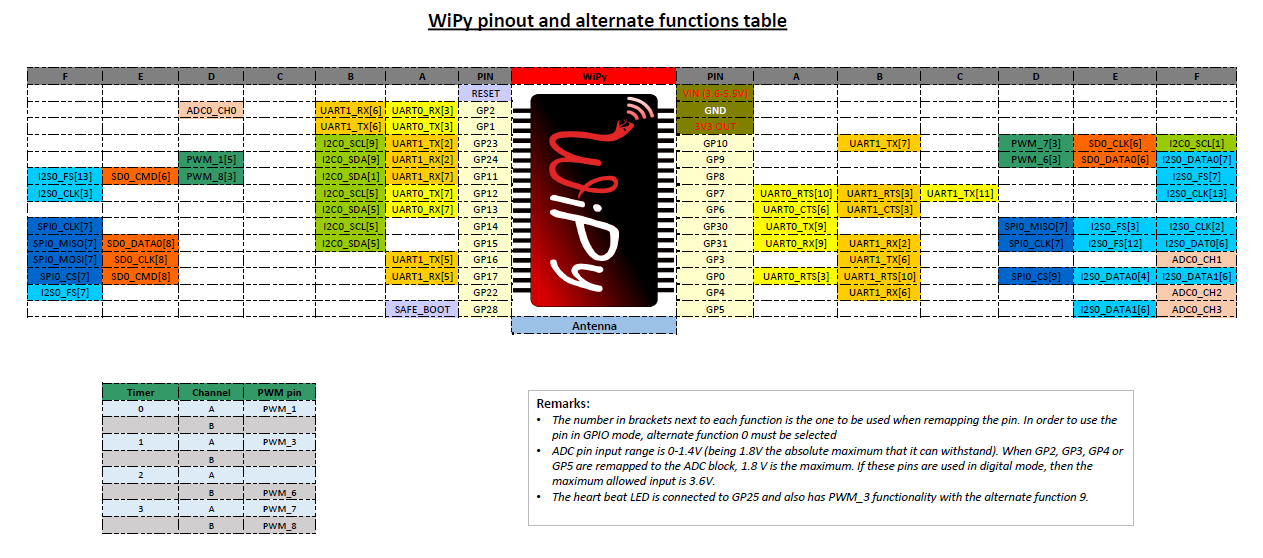Quick reference for the WiPy — MicroPython latest documentation (original) (raw)
Below is a quick reference for CC3200/WiPy. If it is your first time working with this board please consider reading the following sections first:
General board control (including sleep modes)¶
See the machine module:
import machine
help(machine) # display all members from the machine module machine.freq() # get the CPU frequency machine.unique_id() # return the 6-byte unique id of the board (the WiPy's MAC address)
machine.idle() # average current decreases to (12mA), any interrupts wake it up
machine.lightsleep() # everything except for WLAN is powered down (950uA avg. current)
# wakes from Pin, RTC or WLAN
machine.deepsleep() # deepest sleep mode, MCU starts from reset. Wakes from Pin and RTC.
Pins and GPIO¶
See machine.Pin.
from machine import Pin
initialize GP2 in gpio mode (alt=0) and make it an output
p_out = Pin('GP2', mode=Pin.OUT) p_out.value(1) p_out.value(0) p_out.toggle() p_out(True)
make GP1 an input with the pull-up enabled
p_in = Pin('GP1', mode=Pin.IN, pull=Pin.PULL_UP) p_in() # get value, 0 or 1
Timers¶
See machine.TimerWiPy and machine.Pin. Timer id’s take values from 0 to 3.:
from machine import Timer from machine import Pin
tim = Timer(0, mode=Timer.PERIODIC) tim_a = tim.channel(Timer.A, freq=1000) tim_a.freq(5) # 5 Hz
p_out = Pin('GP2', mode=Pin.OUT) tim_a.irq(trigger=Timer.TIMEOUT, handler=lambda t: p_out.toggle())
PWM (pulse width modulation)¶
See machine.Pin and machine.Timer.
from machine import Timer
timer 1 in PWM mode and width must be 16 buts
tim = Timer(1, mode=Timer.PWM, width=16)
enable channel A @1KHz with a 50.55% duty cycle
tim_a = tim.channel(Timer.A, freq=1000, duty_cycle=5055)
ADC (analog to digital conversion)¶
See machine.ADCWiPy.
from machine import ADC
adc = ADC() apin = adc.channel(pin='GP3') apin() # read value, 0-4095
UART (serial bus)¶
See machine.UART.
from machine import UART uart = UART(0, baudrate=9600) uart.write('hello') uart.read(5) # read up to 5 bytes
SPI bus¶
See machine.SPI.
from machine import SPI
configure the SPI controller @ 2MHz
spi = SPI(0, SPI.CONTROLLER, baudrate=2_000_000, polarity=0, phase=0) spi.write('hello') spi.read(5) # receive 5 bytes on the bus rbuf = bytearray(5) spi.write_readinto('hello', rbuf) # send and receive 5 bytes
I2C bus¶
See machine.I2C.
from machine import I2C
configure the I2C bus
i2c = I2C(baudrate=100000) i2c.scan() # returns list of peripheral addresses i2c.writeto(0x42, 'hello') # send 5 bytes to peripheral with address 0x42 i2c.readfrom(0x42, 5) # receive 5 bytes from peripheral i2c.readfrom_mem(0x42, 0x10, 2) # read 2 bytes from peripheral 0x42, peripheral memory 0x10 i2c.writeto_mem(0x42, 0x10, 'xy') # write 2 bytes to peripheral 0x42, peripheral memory 0x10
Watchdog timer (WDT)¶
See machine.WDT.
from machine import WDT
enable the WDT with a timeout of 5s (1s is the minimum)
wdt = WDT(timeout=5000) wdt.feed()
Real time clock (RTC)¶
See machine.RTC
from machine import RTC
rtc = RTC() # init with default time and date rtc = RTC(datetime=(2015, 8, 29, 9, 0, 0, 0, None)) # init with a specific time and date print(rtc.now())
def alarm_handler (rtc_o): pass # do some non blocking operations # warning printing on an irq via telnet is not # possible, only via UART
create a RTC alarm that expires after 5 seconds
rtc.alarm(time=5000, repeat=False)
enable RTC interrupts
rtc_i = rtc.irq(trigger=RTC.ALARM0, handler=alarm_handler, wake=machine.SLEEP)
go into suspended mode waiting for the RTC alarm to expire and wake us up
machine.lightsleep()
SD card¶
See machine.SD.
from machine import SD import vfs
clock pin, cmd pin, data0 pin
sd = SD(pins=('GP10', 'GP11', 'GP15'))
or use default ones for the expansion board
sd = SD() vfs.mount(sd, '/sd')
WLAN (WiFi)¶
See network.WLAN and machine.
import machine, network from network import WLAN
configure the WLAN subsystem in station mode (the default is AP)
wlan = WLAN(mode=WLAN.STA)
go for fixed IP settings
network.ipconfig(dns='8.8.8.8') wlan.ipconfig(addr4='192.168.0.107/24', gw4='192.168.0.1') wlan.scan() # scan for available networks wlan.connect(ssid='mynetwork', auth=(WLAN.WPA2, 'mynetworkkey')) while not wlan.isconnected(): pass
enable wake on WLAN
wlan.irq(trigger=WLAN.ANY_EVENT, wake=machine.SLEEP)
go to sleep
machine.lightsleep()
now, connect to the FTP or the Telnet server and the WiPy will wake-up
Telnet and FTP server¶
See network.Server
from network import Server
init with new user, password and seconds timeout
server = Server(login=('user', 'password'), timeout=60) server.timeout(300) # change the timeout server.timeout() # get the timeout server.isrunning() # check whether the server is running or not
Heart beat LED¶
See wipy.
import wipy
wipy.heartbeat(False) # disable the heartbeat LED wipy.heartbeat(True) # enable the heartbeat LED wipy.heartbeat() # get the heartbeat state
